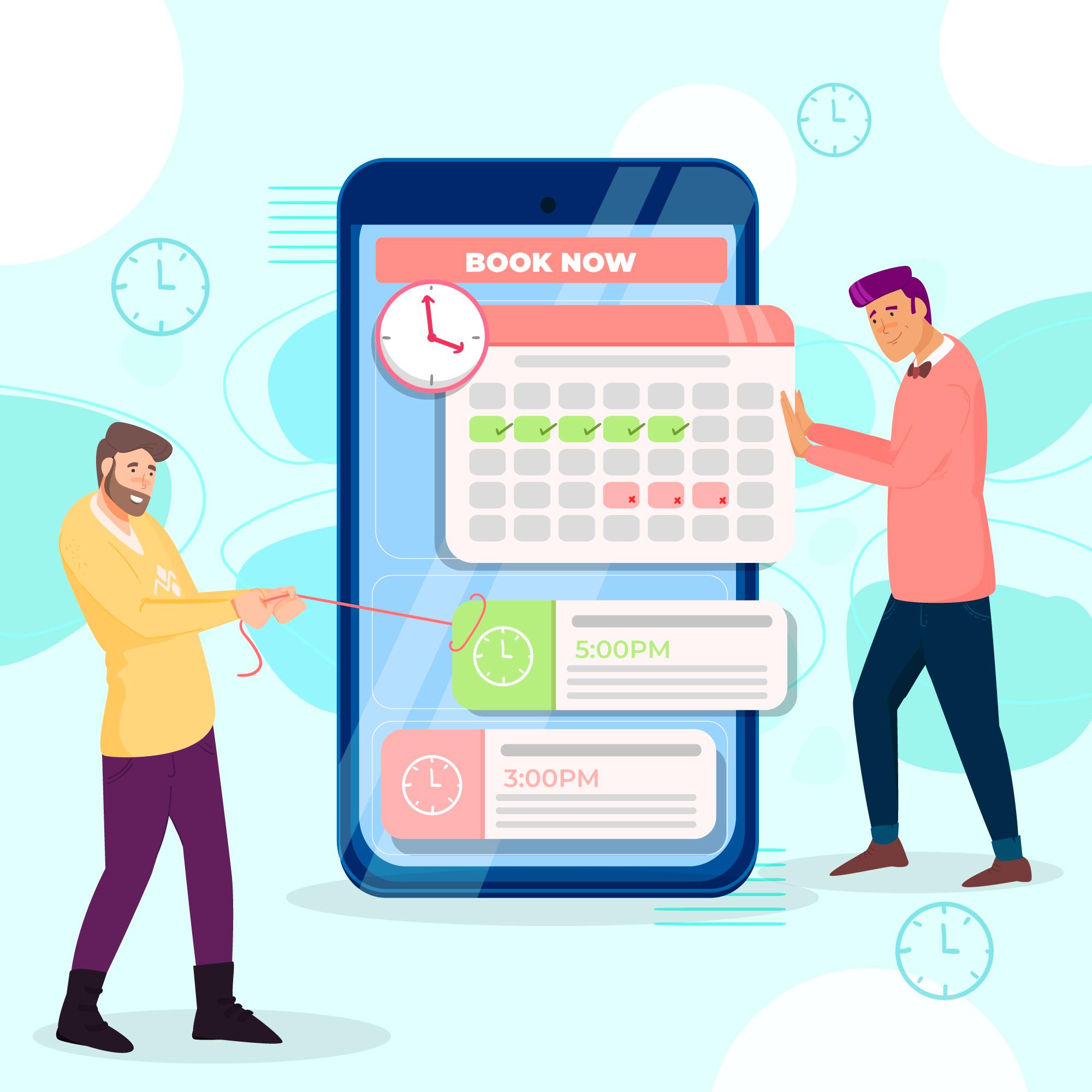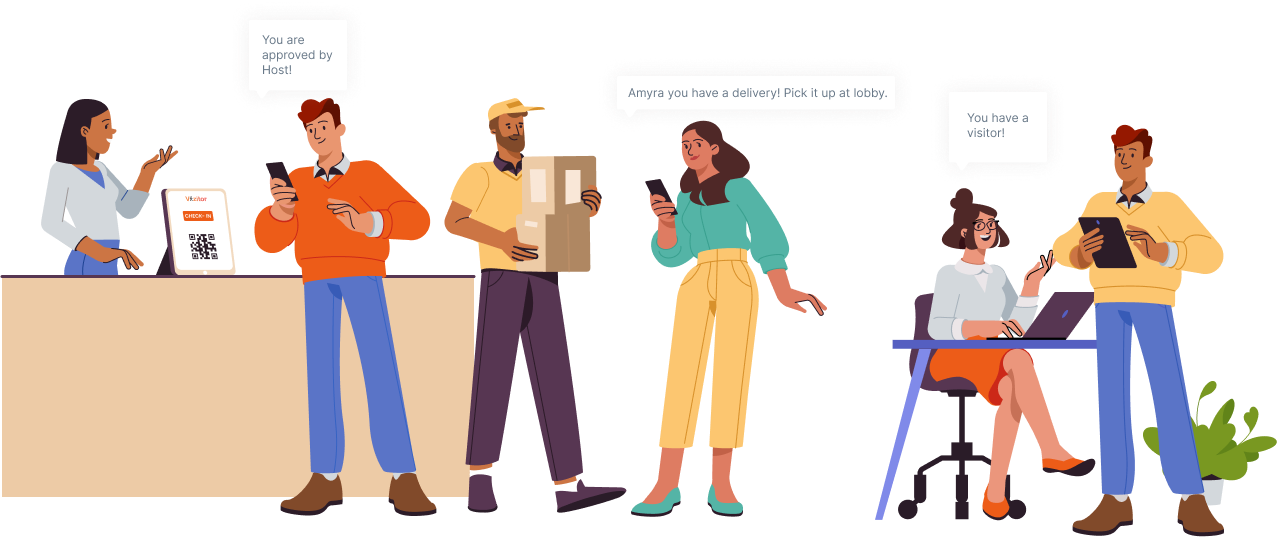Table of Content
Try Vizitor for Free!

Tue, Sep 24, 2024
Read in 12 minutes
A queue is simply a line where people wait. We often associate the word “queue” with waiting, and it’s no secret that most people dislike waiting in line.
In a queue, you usually take a number, often displayed on a piece of paper.Why do queues sometimes feel longer than they are? It’s because the actual wait time can be different from how long it feels to us. By making the waiting experience more pleasant, businesses can make this wait seem shorter. This also shows customers that they truly come first, not just in words but in actions.
However, problems arise when there are more unhappy customers than happy ones. Since customer experience is critical, businesses need to prevent these unhappy customers from leaving for a competitor.
According to a report by the Harvard Business Review, as many as 50% of customers have switched companies due to poor service, emphasizing the need for efficient queue management.
Many businesses wonder how they can reduce waiting times. In this blog post, we’ll discuss ways to cut down on waiting times and improve the overall customer experience. The adoption of digital queue management systems has been shown to reduce customer wait times by up to 30%, according to a 2020 industry report.
Queue-Related Issues
Long queues are often a source of frustration, leading to unhappy customers and lost business opportunities. Issues like extended check-in times, lack of transparency on waiting times, and overcrowded queues are common challenges. To address these, businesses need effective waiting time management strategies that help reduce queue times and improve customer satisfaction. Keywords: customer waiting, waiting time for customer, waiting time management, reduce queue
Why should businesses focus on reducing customer waiting times in queues?
There are two big reasons why shorter lines are a win for everyone:
1. Happy Customers, Happy Business: Nobody enjoys feeling stuck in a long line. Long waits can lead to frustration and even anger, which can hurt a business’s reputation. By keeping lines moving and wait times short, customers have a more positive experience and are more likely to return.
2. Perception is Key: Even if a line isn’t super long if it feels like it takes forever, customers get grumpy. The key is perceived wait time - how long the wait feels compared to the actual time. By making queues more engaging and interesting, the wait seems shorter, keeping customers feeling good.
By using these effective strategies, businesses can reduce waits, keep customers coming back, and make their operations smoother.
6 Ways To Reduce Queue Waiting Times
These 9 queue management strategies can help to reduce wait times and enhance the overall customer experience.
1. Enhance Customer Experience through Transparency
Transparency is King: Keeping Customers Informed in Queues
Did you know that 73% of customers say they’d abandon a queue if the wait time seems unreasonable? Transparency is key! When customers are kept in the dark about wait times and queue movement, frustration builds. Imagine being stuck in line, unsure of how long it’ll take or why things aren’t moving. It’s not exactly a recipe for a happy customer experience.
Here’s the good news: Businesses don’t need to operate like a top-secret government agency (Area 51, anyone?). Open communication with customers goes a long way.
What kind of information do customers crave?
• Estimated Wait Time: How long will this take? This simple piece of information helps customers manage their expectations and feel more in control.
• Reason for Delays: Is there a system slowdown, or are there complex transactions ahead? Sharing this context helps customers understand the situation.
• Queue Position: Knowing where they are in line can ease customer anxiety.
Empowered Staff, Empowered Customers
When staff is equipped to answer these questions confidently, customer experience improves dramatically. Imagine a friendly employee able to say, “There’s currently a slight delay due to a complex transaction, but you should be next within 5 minutes." This simple explanation can make a world of difference.
The Power of Queue Management Systems
Manually tracking queues can be unpredictable.Automated Queue Management Systems (QMS)provide a solution.
Here’s how a QMS can transform your waiting experience:
• Real-Time Information: Customers see clear wait times and queue position displayed on screens, eliminating the guessing game.
• Reduced Stress: Knowing what to expect helps customers feel more relaxed and in control.
• Improved Staff Efficiency: QMS streamlines queue management, freeing staff to focus on customer service.
• Setting up a QMS is surprisingly simple. It’s a wireless system typically involving a tablet or iPad for check-in, connection to your store’s system, and a large screen displaying wait times.It’s all about keeping your customers informed and engaged, leading to a more positive and productive experience.
• Ready to ditch the frustration and embrace transparency? There’s no need to be a mystery anymore. Sign up for a QMS and see the difference it can make!
2. Make Waiting in Line Fun (and Keep Customers Coming Back)
Let’s be honest: waiting in line is universally dreaded.Did you know that a whopping 73% of customers report feeling frustrated by slow lines? But what if that wait time could be transformed into a positive experience?
Here’s the key: engagement is everything. Ditch the impersonal paper tickets and silent lines that scream “boredom zone.” Imagine interactive screens, engaging games, or even the chance to contribute to the entertainment like Disney’s famous Monster’s Inc. Laugh Floor! By keeping customers occupied and feeling valued, you achieve two major wins:
1. Happier Customers: Engaged customers are less likely to get frustrated by wait times. Studies show that perceived wait time (how long the wait feels) is more important than the actual time spent in line. By keeping minds occupied and emotions positive, the wait seems to fly by.
2. Stronger Customer Loyalty: When customers feel valued and entertained during their wait, they’re more likely to view your business favorably. This translates to repeat business and positive word-of-mouth recommendations.
It’s not about creating a full-blown amusement park experience, but rather acknowledging that boredom is the enemy. Put yourself in your customer’s shoes: would you rather spend 10 minutes waiting passively or 10 minutes engaged in a fun activity? The answer is clear!
The “Customer is Always Right” mentality can be taken a step further: how about “The Customer is Always Entertained!" By prioritizing customer engagement during queues, you’ll create a more positive experience, boost customer loyalty, and ultimately drive business growth.
3. The Importance of Fairness: Keeping Lines Orderly and Customers Happy
Did you know that fairness is the secret weapon of a happy queue? It might sound obvious, but in the world of customer experience, a fair queuing system can make all the difference.
Imagine you’re in line at a store, excited about your purchase. Suddenly, someone cuts in front! This frustration is a common experience in unmanaged queues, leading to negativity and a damaged customer experience.
Surveys show that over 70% of customers have abandoned a purchase due to long wait times or unfair queuing. Yikes! That’s a lot of lost business.
So, what makes a fair queuing system? It all boils down to queueing discipline, which is simply the rule used to decide who gets served next. Two common rules are:
•First-In, First-Out (FIFO): The classic “wait your turn” approach. The person who arrives first gets served first.
• Last-In, First-Out (LIFO): Less common, but occasionally used for specific situations. The most recently arrived person gets served first.
In a fair system, everyone follows the same rules. Think about it: When everyone waits patiently, doesn’t it make the whole experience more pleasant?
Science backs this up! Studies by Stanley Milgram showed that people are more likely to tolerate waiting when everyone follows the same queuing rules.
But what about queue jumpers? This is where traditional queues fall short. Unruly customers can disrupt the flow, causing frustration and a breakdown in fairness.
This is where a Queue Management System (QMS) shines! With a QMS, fairness is built-in. The system automatically assigns tickets or positions in the queue, eliminating the possibility of line-cutting. Everyone is treated equally, and customers can see their place in line transparently.
Remember, happy customers are loyal customers. By implementing a fair queue management system, you’re showing your customers that you value their time and experience. That’s a win-win for everyone!
4. Ditch the Paper, Embrace Happy Customers
Did you know? Studies show that a whopping 70% of customers abandon their carts due to long wait times. That’s a scary statistic for any business!
But what if waiting in line could be a positive experience, even a little enjoyable? The key is modern queue management systems (QMS).
Imagine ditching the impersonal paper ticket system. Instead, customers can use a tablet to check in, providing their name for a personalized touch. This simple gesture goes a long way: research shows that people respond positively to being addressed by name by a stranger.
Qminder’s name-based queuing system takes this concept to the next level. Customers feel valued and in control as they check themselves in, and the system remembers their name throughout their service session.
But the benefits don’t stop there:
Clear Information: Gone are the days of wondering how long the wait will be. QMS provides real-time wait time estimates, allowing customers to relax or browse instead of feeling stuck.
Reduced Stress: Knowing exactly where they are in line removes the anxiety of “am I ever going to get served?” This leads to happier customers who are more likely to return for a positive experience.
Boosted Efficiency: QMS helps streamline operations, allowing staff to better manage their workload and serve customers faster. This translates to shorter overall wait times for everyone.
The Bottom Line: Modern queue management systems are a win-win for businesses and customers alike. Reduced wait times, increased customer satisfaction, and improved efficiency are just a few of the benefits.
Ready to transform your waiting experience? Sign up for your free 14-day trial of Vizitor and see the difference a QMS can make! You can also schedule a demo to get a personalized walk-through and see Vizitor in action.
5. People Counting for Smarter Queues (and More!)
Did you know? Accurately counting customers entering and exiting your store provides a wealth of valuable data. Vizitor queue management systems with built-in people counting technology go beyond simple headcounts. They offer real-time insights like:
• Current number of customers - No more guessing! This helps predict peak hours and staff accordingly.
• Historical foot traffic patterns - Analyze busy and slow periods to optimize staffing and layout.
• Insights into customer behavior - Use data to redesign your store layout for better flow and reduced crowding.
The benefits?
• Reduced wait times: Knowing how many customers are waiting allows for better staff allocation and faster service.
• Improved customer experience: Nobody likes feeling like a number. Shorter waits and a well-managed flow keep customers happy.
• Data-driven decisions: Use real numbers to make informed choices about staffing, store layout, and marketing efforts.
People counting integrates seamlessly with digital signage and virtual queuing systems. Imagine customers walking in and seeing the real-time wait time displayed on a screen. This transparency builds trust and reduces frustration.
6. Self-Service Kiosks: Empowering Customers, Streamlining Operations
60% of customers now expect self-service options. Vizitor’s self-service kiosks queuing system empower customers to take control of their experience, offering features like:
• Check-in: Skip the line and check in with a few taps.
• Ticket booking: Book appointments or print tickets without waiting.
• Order placement: Order food or products directly from the kiosk.
Benefits for both you and your customers:
• Reduced wait times: Kiosks handle routine tasks, freeing up staff for more complex transactions.
• Improved customer satisfaction: Customers appreciate the convenience and control self-service offers.
• Increased efficiency: Streamlined processes mean faster service and happier customers.
• Reduced contact: Self-service kiosks offer a contactless option, ideal for health-conscious customers.
Self-service kiosks are versatile solutions. They can be used in various industries, including:
• Retail: Check-in, order placement, product information.
• Healthcare: Appointment booking, patient check-in, insurance verification.
• Banking: Account access, bill payments, money transfers.
• Telecommunications: Bill payments, plan changes, device upgrades.
By implementing people counting and self-service kiosks, you can create a smoother, more efficient customer experience. Reduced wait times, empowered customers, and data-driven decision-making all lead to a happier customer base and a more successful business.So, what are you waiting for?
Understanding Queues and How to Keep Customers Happy
Ever wonder how lines work? There are different types!
Single-Counter Queues: This is the classic line you see at a small store. One server, one line that snakes its way around. Businesses need to plan space carefully for this setup.
Multiple-Counter Queues: Bigger stores often have these, with several lines feeding into different service points. It might seem faster, but wait times can vary depending on which line you choose.
Single-Line, Multiple Server Queues: This is a mix of both. You join one line, then get directed to an available server when it’s your turn.
Why are Short Lines Important?
Did you know a whopping 86% of customers leave because of long lines? Yikes! Long waits can hurt your business in several ways:
Customers Go Elsewhere: People will flock to competitors with shorter lines, taking their business with them.
Brand Image Takes a Hit: Word travels fast. Bad experiences spread easily, damaging your brand reputation. On the flip side, fast service can boost your image and attract new customers.
What Causes Long Lines?
Several factors can contribute to frustrating wait times:
Slow Service: Maybe staff is new, technology is glitchy, or procedures are too complex. All these lead to long waits and unhappy customers.
High Customer Volume: Busy times, holidays, or sales can overwhelm your staff, resulting in long lines.
Limited Resources: Not enough cashiers, service points, or equipment can bottleneck the flow of customers.
Inefficient Management: Poor signage, lack of technology, or disorganized systems all create confusion and longer waits.
Customer Behavior: Indecisive customers or those who miss appointments can slow things down for everyone.
The Power of Short Waits (and How We Can Help!)
Our queue management system uses cutting-edge technology to:
• Reduce Wait Times by 40% on Average: Happier customers mean better business!
• Optimize Operations: We help you streamline processes and allocate resources effectively.
Don’t Let Long Lines Drag You Down! Sign up for a free 1-month trial of our queue management system and see the difference for yourself. Stop frustrated customers in their tracks and keep your business running smoothly.
Ready to ditch the queue blues? Click here to get started.












